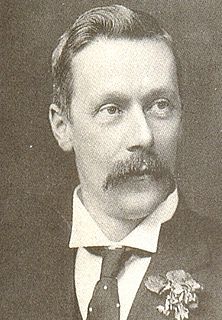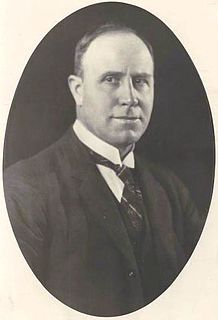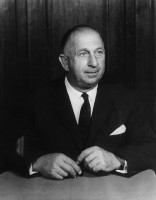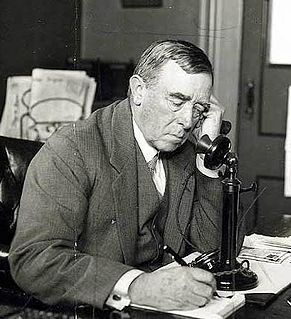Peter Ronald Hall is an Australian retired politician. He was a National member of the Victorian Legislative Council from 1988 to 2014, representing Gippsland Province (1988–2006) and the Eastern Victoria Region (2006–2014).

Sir George Turner was an Australian politician. He served two terms as Premier of Victoria, holding office from 1894 to 1899 and 1900 to 1901 as a liberal. After Federation he was invited by Edmund Barton to join the inaugural federal ministry, becoming the first Treasurer of Australia. He held office until 1904 under Barton and Alfred Deakin, then a few months later resumed office under George Reid. The government fell in 1905 and Turner retired from politics at the 1906 election.

John Cain was an Australian politician, who became the 34th premier of Victoria, and was the first Labor Party leader to win a majority in the Victorian Legislative Assembly. He is the only premier of Victoria to date whose son has also served as premier.

William Alexander Watt was an Australian politician. He served two terms as Premier of Victoria before entering federal politics in 1914. He then served as a minister in the government of Billy Hughes from 1917 to 1920, including as acting prime minister during World War I, and finally as Speaker of the House of Representatives from 1923 to 1926.

Sir Alexander James Peacock was an Australian politician who served as the 20th Premier of Victoria.

Sir John Bowser, Australian politician, was the 26th Premier of Victoria. He was born in London, the son of an army officer, and arrived in Melbourne as a child with his family. He grew up at Bacchus Marsh and when he left school got a job with the Bacchus Marsh Express. As a young man he went to Scotland and worked on newspapers while studying at Edinburgh University. Returning to Australia, he settled in Wangaratta, where he farmed and managed the Wangaratta Chronicle, which he eventually bought.

Sir Harry Sutherland Wightman Lawson KCMG, was an Australian politician who served as Premier of Victoria from 1918 to 1924. He later entered federal politics, serving as a Senator for Victoria (1929–1935) and briefly as a minister in the Lyons Government. He was a member of the Nationalist Party until 1931, when it was replaced with the United Australia Party.

The 1999 Victorian state election, held on Saturday, 18 September 1999, was for the 54th Parliament of Victoria. It was held in the Australian state of Victoria to elect the 88 members of the state's Legislative Assembly and 22 members of the 44-member Legislative Council. The Liberal–National Coalition led by Jeff Kennett and Pat McNamara, which had held majority government since the 1996 election, lost 15 seats and its majority due mainly to a swing against it in rural and regional Victoria.

The 2006 Victorian state election, held on Saturday, 25 November 2006, was for the 56th Parliament of Victoria. Just over 3 million Victorians registered to vote elected 88 members to the Legislative Assembly and, for the first time, 40 members to the Legislative Council under a proportional representation system. The election was conducted by the independent Victorian Electoral Commission.
The Victorian Farmers' Union (VFU) was an association of farmers and primary producers formed in 1914 in the Australian state of Victoria. Although initially formed as an "absolutely non-political" entity, the VFU became a political party in 1916, and nominated candidates for the 1917 state election and subsequent elections. In later years it used the names Victorian Country Party, then United Country Party and is now the National Party of Australia – Victoria. At the 1917 election, because the support for the VFU was concentrated in rural seats, it won four of the 11 seats in the Victorian Legislative Assembly it contested, gaining about 6% of the vote state-wide. In 1918 it also won its first seat in the federal parliament, after preferential voting was introduced. At the 1920 state election the VFU vote increased to 8% and the number of seats to 13, giving the VFU the balance of power in the state Legislative Assembly.

Gary John Blackwood is an Australian politician. He has been a Liberal Party member of the Victorian Legislative Assembly since November 2006, representing the electorate of Narracan.
The National Party of Australia (WA) Inc, branded The Nationals WA, is a political party in Western Australia. It is affiliated with the National Party of Australia but maintains a separate structure and identity. Since the 2021 state election, the Nationals WA was the senior party in an opposition alliance with WA Liberal Party in the WA Parliament. Prior to the election, the National Party was sitting in the crossbench and the Liberal Party was the sole opposition party. The election resulted in the National Party winning more seats than the Liberal Party and gaining official opposition status. Under the opposition alliance, the National Party leader and deputy leader would be the opposition leader and deputy opposition leader respectively, the first since 1947, and each party would maintain their independence from each other.

The 1955 Victorian state election was held in the Australian state of Victoria on Saturday 28 May 1955 to elect 65 members of the state's Legislative Assembly.

The 1940 Victorian state election was held in the Australian state of Victoria on Saturday 16 March 1940 to elect 44 of the 65 members of the state's Legislative Assembly.

The 1932 Victorian state election was held in the Australian state of Victoria on Saturday 14 May 1932 to elect 44 of the 65 members of the state's Legislative Assembly. The other 21 seats were uncontested.

The 1924 Victorian state election was held in the Australian state of Victoria on Thursday 26 June 1924 to elect the 65 members of the state's Legislative Assembly.

The 1920 Victorian state election was held in the Australian state of Victoria on Thursday 21 October 1920 to elect the 65 members of the state's Legislative Assembly.

The 1917 Victorian state election was held in the Australian state of Victoria on Thursday 15 November 1917 for the state's Legislative Assembly. 51 of the 65 Legislative Assembly seats were contested.
The Australian Labor Party , commonly known as Victorian Labor, is the semi-autonomous Victorian branch of the Australian Labor Party (ALP). The Victorian branch comprises two major wings: the parliamentary wing and the organisational wing. The parliamentary wing comprising all elected party members in the Legislative Assembly and Legislative Council, which when they meet collectively constitute the party caucus. The parliamentary leader is elected from and by the caucus, and party factions have a strong influence in the election of the leader. The leader's position is dependent on the continuing support of the caucus and the leader may be deposed by failing to win a vote of confidence of parliamentary members. By convention, the premier sits in the Legislative Assembly, and is the leader of the party controlling a majority in that house. The party leader also typically is a member of the Assembly, though this is not a strict party constitutional requirement.

The Liberal Party of Australia , branded as Liberal Victoria, and commonly known as the Victorian Liberals, is the state division of the Liberal Party of Australia in Victoria. It was formed in 1949 as the Liberal and Country Party (LCP), and simplified its name to the Liberal Party in 1965.














